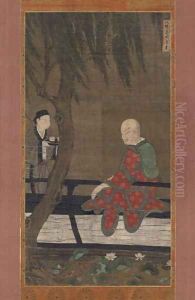Lu Xinzhong Paintings
Lu Xinzhong, born in 1954 in Jiangsu Province, China, is a prominent figure in contemporary Chinese art, renowned for his mastery in traditional Chinese painting techniques while incorporating modern sensibilities. His journey into the art world began at a young age, deeply influenced by the rich cultural heritage of his homeland as well as the tumultuous period of the Cultural Revolution. Despite the challenges of the time, Lu's passion for art remained unwavering, leading him to pursue formal education in the field. He graduated from the Nanjing Art Institute, where he honed his skills and deepened his understanding of traditional Chinese art forms, particularly ink painting.
Lu Xinzhong's body of work is characterized by its elegant fusion of classical and contemporary elements. His paintings often depict serene landscapes, historic scenes, and detailed portrayals of nature, executed with a precision and sensitivity that is indicative of his deep respect for his cultural heritage. Yet, Lu's work is not merely a continuation of traditional practices; he is known for experimenting with new techniques and materials, pushing the boundaries of conventional ink painting to include broader, more universal themes and aesthetics.
Throughout his career, Lu Xinzhong has gained significant recognition both in China and internationally. His artworks have been featured in numerous exhibitions around the world, showcasing his talent to a global audience and earning him awards and accolades in various countries. Beyond his achievements as an artist, Lu has also contributed to the academic field, sharing his knowledge and expertise with younger generations through teaching positions at art institutions.
Lu Xinzhong's contribution to the world of art extends beyond his paintings. He is viewed as a bridge between the past and present, embodying the spirit of innovation within the framework of tradition. His works not only celebrate the beauty and depth of Chinese culture but also engage in a dialogue with contemporary issues and perspectives, making him a pivotal figure in the ongoing evolution of Chinese art.
